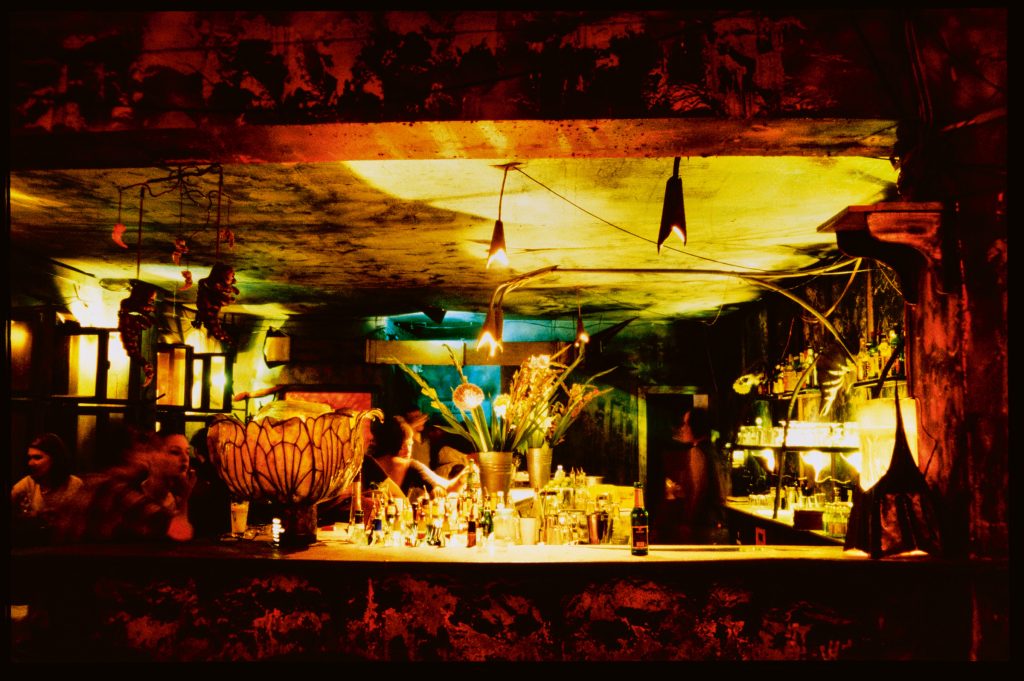Rough, metallic and mysteriously sublime, its entrance rises from the winding facades patinated with street art and graffiti. Step by step, leaving the iron door behind, a dimly lit yet lively microcosm opens up, in which an unadulterated mixture of creativity, inspiration, happenings and encounters rumble. A bar is seldom described in terms of its imagery. Eschschloraque Rümschrümp, however, is unlike any other. Be it a café or a cocktail bar, the uniquely animated space with a stirring and unforced dynamic undercurrent is, first and foremost, an artist’s club.

In the midst of the “mainstream chic” and the rampant gentrification of the surrounding neighbourhood, Eschschloraque is a refuge for independent art and alternative club culture. It is simultaneously a place of encounter and creative production. It is home to an extraordinary program of concerts, performances and DJ nights where Berlin's avant-garde and hidden gems from the independent scene are brought together on stage. The crowd is equally diverse, including local and international artists, alternative thinkers, art enthusiasts, explorers, and Berliners both old and new. It comes as no surprise that, according to the movement of the mix, anything is possible: On more relaxed evenings, some may remain at the bar, involved in pleasantly strange conversations. Frequently though, the party explodes quite unexpectedly and a drink leads to dancing in the spotlight.


of DJ sets and concerts, while the freedom to experiment and develop is perpetuated in dance events and other performances. The vitality coursing through the artists’ club is a nostalgic, vibrating esprit of the 1990s that brings contemporary, unconventional art and music to life in the here and now of the authentic Berlin underground.
In Eschschloraque today, however, one’s sense of time is immediately suspended when everyday life dissolves in a psychedelic-fluorescent maelstrom, refracting in the
intense red-blue of the spotlights and the ghostly greengrey of the walls, evaporating in the deep purple of the stage or the steely, organic blue-grey of the bar, or blossoming
in the summer cocktail garden in a moment of
rest and recreation in the courtyard.
To simply let oneself drift, removed from the rest of the world, is the freedom of ‘Rümschrümpen’ – Eschschloraque the once engrained, never to be forgotten name for a place that always casts a wayward spell.

The fact that Eschschloraque has been generating this allure since 1995 confers somewhat of a cult status upon it and is a testament to its remarkable resilience in times when more and more art and cultural projects are forced to move... and meanwhile monsters watch over the semi-darkness of the interior of the club and the courtyard cocktail garden. The monsters are creatures of the Dead Chickens, an artists' group founded in the 1980s in Berlin, two members of which co-founded Eschschloraque and still run it today. With their experience in organising project spaces for the independent scene, and in search of a new location for the Dead Chickens, they, along with other creative artists, founded Schwarzenberg e.V. and Haus Schwarzenberg. Since its establishment, Eschschloraque has been at the centre of this independent cultural house.
The artists' club is thus also a living document of art and time, which, due to its ever regenerating diversity, cannot be categorised as a museum, but rather as a place that exists independent of the constraints of time. As well as being a living reminder of the anarchic times of the nineties and the subsequent appropriation of space, Eschschloraque shows a radical will to create art. The space achieves a balancing act between survival and commercialisation in order to thrive as an artists' club. Since its inception, it has been a meeting place for creatives; a shared space for experimentation and development, into which the craft of the Dead Chickens is inscribed. While the creation of fantastically whimsical worlds where the movement of kinetic sculptures brings the static nature of metal art to life is their hallmark, the Dead Chickens are instrumental in incorporating organic influences into the art of metal. They expand the boundaries of raw, sharp-edged metal “hard art” into a moving, poetically avant-garde work. Their art transforms Eschschloraque into a meeting and event space that is equally convivial and atmospheric.
The openness to artistic expression beyond the mainstream is also reflected in the wide-ranging musical spectrum
Text Vera Fischer
